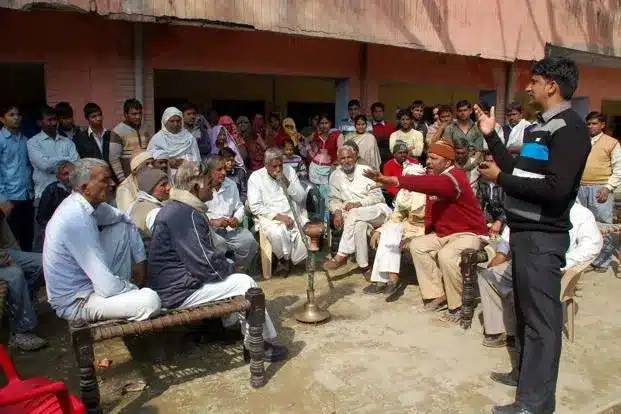What’s in today’s article?
- Why in News?
- What is the 74th Constitutional Amendment?
- Need for Robust ULBs
- Key Findings from the CAG Report on ULBs
- Call for Strengthening ULBs
- Conclusion
Why in News?
- The Comptroller and Auditor General (CAG) of India has flagged significant concerns about the health of urban local bodies (ULBs) in 18 states, which cater to 241 million residents.
- The report reveals systemic weaknesses in financial management, staffing, and functional autonomy, undermining the goals of the 74th Constitutional Amendment.
What is the 74th Constitutional Amendment?
- About: The 74th Constitutional Amendment Act of 1992 gave constitutional status to Urban Local Bodies (ULBs) and established them as the lowest unit of governance in cities and towns.
- Deals with: It established a framework for urban governance in India by decentralisation of powers and authority.
- Constitutional provisions:
- The amendment added Part IX-A to the Constitution, which deals with municipalities and is made up of Articles 243-P to 243-ZG.
- The amendment mandates the devolution of 18 functions to ULBs [Schedule 12 (Article 243W)], including urban planning, public health, and water supply.
Need for Robust ULBs:
- With 50% of India’s population expected to reside in urban areas by 2050, strong urban governance systems are essential.
- Empowered ULBs can play a pivotal role in ensuring economic, environmental, and democratic vibrancy in cities.
Key Findings from the CAG Report on ULBs:
- Incomplete devolution of powers:
- The 1992 amendment aimed to decentralise 18 functions to ULBs, but only 4 functions have been devolved with complete autonomy after 30 years.
- States have failed to comply with the “in-spirit reading” of the amendment, as observed in 393 ULBs across 18 states including Andhra Pradesh, Assam, Haryana, Himachal Pradesh, Odisha, MP, Maharashtra, etc.
- Financial gaps and dependency:
- Urban local bodies face a 42% gap between their resources and expenditure.
- Only 32% of revenue is internally generated, with the rest coming from Union and state government funding.
- Property tax, a major revenue source, showed only 56% realisation of the total demand.
- Limited expenditure on development:
- Merely 29% of ULB expenditure is directed towards developmental and programmatic work.
- Insufficient investment in civic programs hampers urban growth and quality of life.
- Staffing issues:
- Urban bodies face an average 37% vacancy rate in sanctioned staff positions.
- Recruitment powers are restricted, with ULBs in 16 states having limited or no control over staffing.
Call for Strengthening ULBs:
- Recommendations by CAG:
- Enhance financial autonomy: Grant ULBs control over taxation and user charges.
- Improve revenue collection mechanisms: Streamline property tax and other revenue sources.
- Focus on fund utilisation: Ensure optimal use of allocated funds for development.
- Strengthen decentralisation: Revive the agenda of empowering ULBs politically and administratively.
- Call for collaboration: Since empowering ULBs is a national priority, cooperation between the government, academia, and civil society is essential to reaching this objective.
Conclusion:
- The CAG’s findings emphasise the urgent need to revamp the financial and administrative structures of ULBs.
- Empowering these “first-mile governments” is critical for sustainable urban governance and achieving the goals of the 74th Constitutional Amendment.
- Therefore, States must facilitate laws and policies to strengthen ULBs. Urban local bodies should be actively involved in planning and governance functions.
Q.1. What is the 73rd Amendment to the Constitution of India?
The 73rd Amendment to the Constitution of India, passed in 1992, strengthened the Panchayati Raj system and made it a part of the administrative process.
Q.2. What is the office of CAG in India?
The Comptroller and Auditor General of India is the supreme audit institution of India, established under Article 148 of the Constitution of India.
News: What is ailing urban local bodies in 18 states: CAG flags 42% resource-expenditure gap, 37% staff vacancy | ToI
Last updated on June, 2025
→ UPSC Notification 2025 was released on 22nd January 2025.
→ UPSC Prelims Result 2025 is out now for the CSE held on 25 May 2025.
→ UPSC Prelims Question Paper 2025 and Unofficial Prelims Answer Key 2025 are available now.
→ UPSC Calendar 2026 is released on 15th May, 2025.
→ The UPSC Vacancy 2025 were released 1129, out of which 979 were for UPSC CSE and remaining 150 are for UPSC IFoS.
→ UPSC Mains 2025 will be conducted on 22nd August 2025.
→ UPSC Prelims 2026 will be conducted on 24th May, 2026 & UPSC Mains 2026 will be conducted on 21st August 2026.
→ The UPSC Selection Process is of 3 stages-Prelims, Mains and Interview.
→ UPSC Result 2024 is released with latest UPSC Marksheet 2024. Check Now!
→ UPSC Toppers List 2024 is released now. Shakti Dubey is UPSC AIR 1 2024 Topper.
→ Also check Best IAS Coaching in Delhi
























